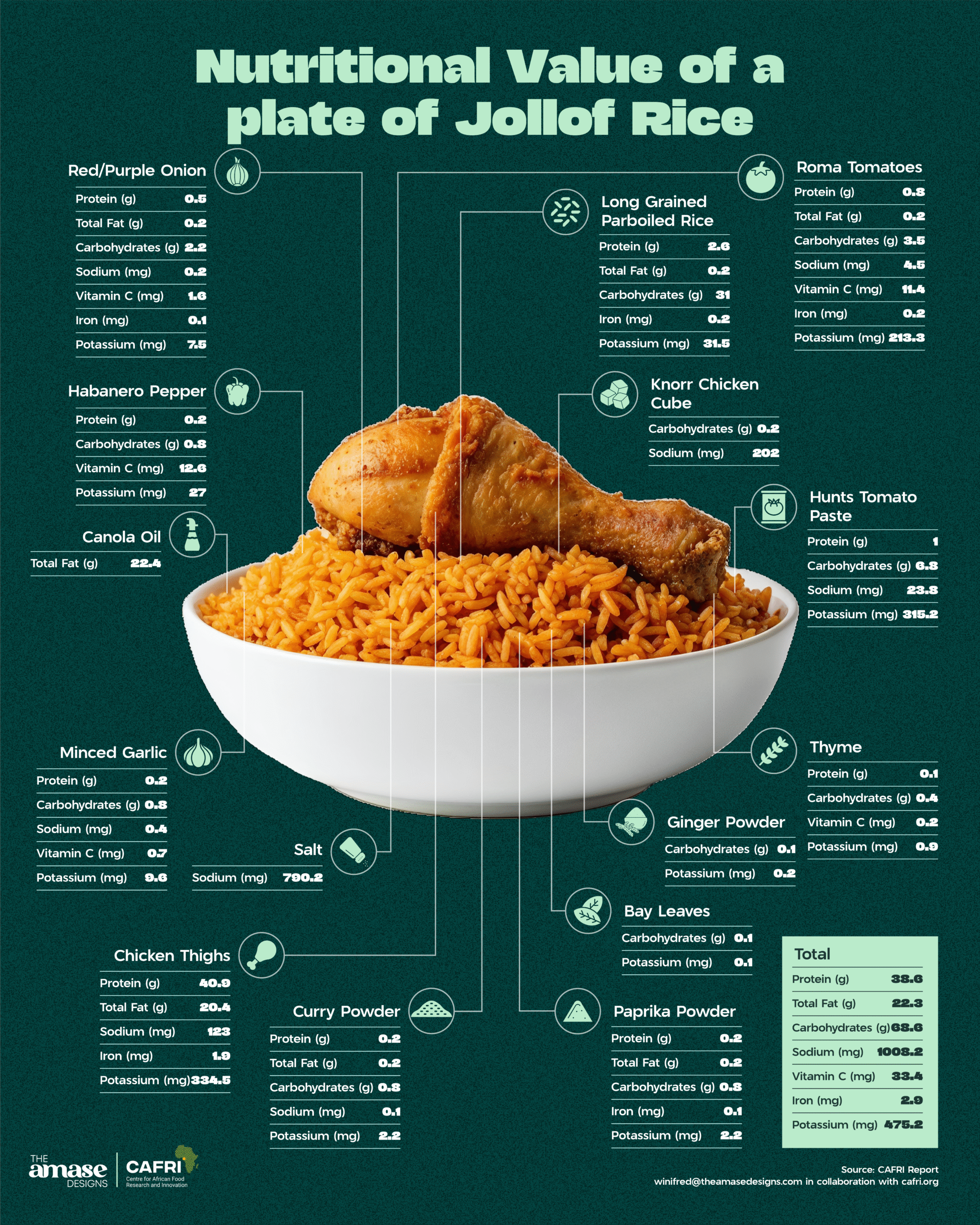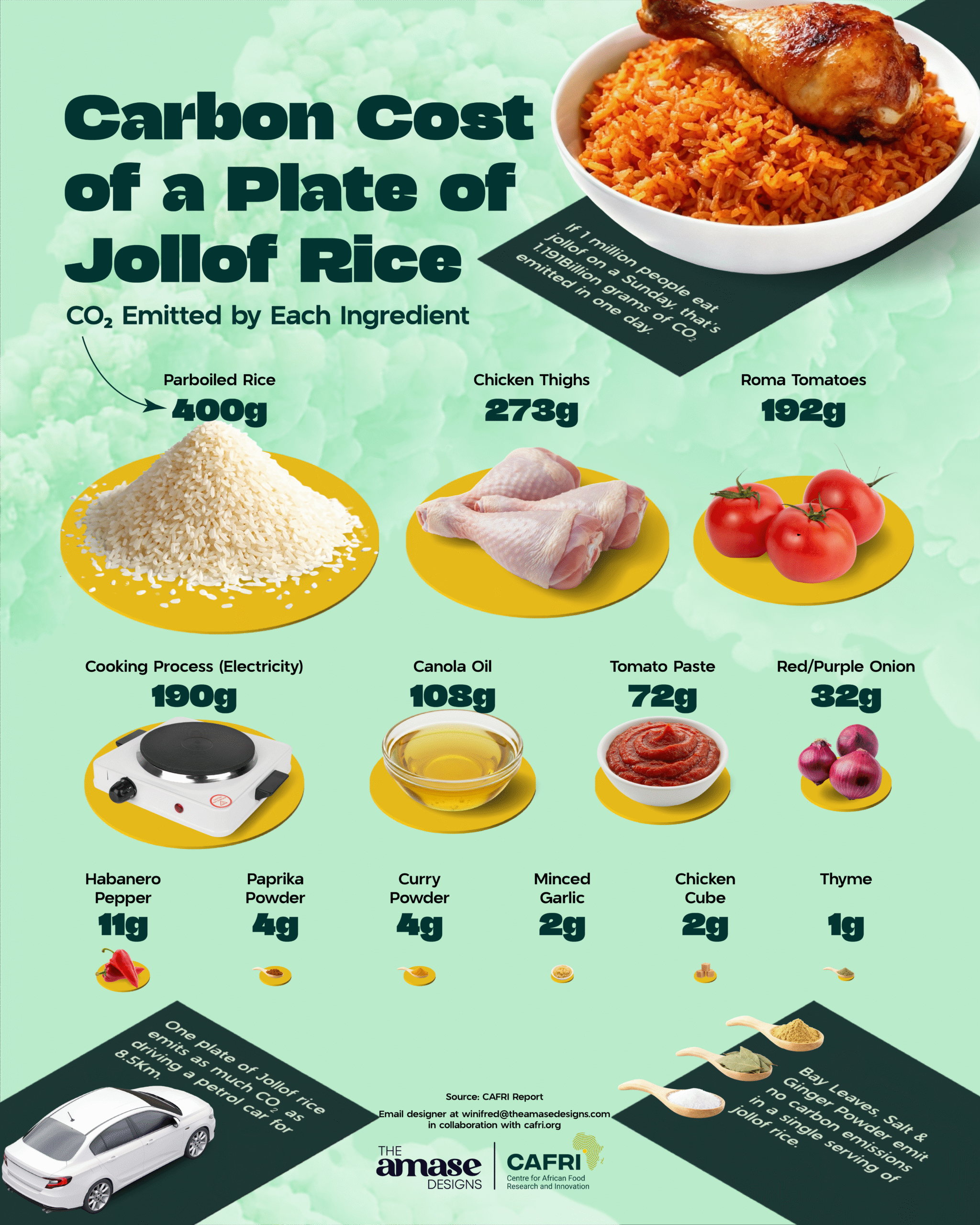Across West Africa, few dishes command reverence like Jollof Rice. Long before it reaches the plate, it has already declared the atmosphere of the gathering. Its aroma carries the promise of celebration. Its colour brightens moments of joy. Its recipe becomes a signature of household identity. Yet beneath this cultural magnitude is a quieter, less explored dimension of the dish: what one serving actually does to the body and what it costs the planet that feeds us.
“The greatest glory in living lies not in never falling, but in rising every time we fall.”
~ Nelson Mandela
This is not a call to change tradition. It is an invitation to understand it. Because the deeper the understanding, the stronger the appreciation.
The body behind the plate

One serving of Jollof Rice is far more than a comfort food. It is a complex nutritional system layered into a single meal. The rice provides the foundational energy, delivering more than half of the plate’s total calories through its carbohydrate structure. That energy becomes the fuel the body runs on, powering thought, movement, and metabolic functions.
Then comes the chicken. With about one hundred and fifty grams of chicken thighs per serving, the dish offers almost forty grams of protein, enough to meaningfully support the body’s repair systems, immune responses, and cellular processes. This is not incidental. It is part of what makes traditional meals intuitively balanced: they often pair a high-energy staple with a protein-dense accompaniment in a way modern fast foods rarely do.
The oil we often overlook plays a role, too. About twenty-two grams of canola oil per serving becomes a concentrated source of fat, most of it unsaturated. These fats support hormone production, nutrient absorption, and brain function. In many ways, the oil binds the nutritional layers of the dish just as it binds the flavours.
But the soul of Jollof sits in its colours. The tomatoes, peppers, onions, garlic, spices, and herbs form the micronutrient identity of the meal. They deliver Vitamin C, Vitamin A, folate, potassium, magnesium, iron, and an array of antioxidants, including lycopene from tomatoes, capsaicin from peppers, anthocyanins from onions, and the aromatic bioactive compounds from thyme, curry, and garlic. These micronutrients and phytochemicals often appear in small amounts individually, but together they turn Jollof into a nutrient-dense traditional food that far exceeds the nutritional complexity of many global processed dishes.
Yet this same dish carries a shadow embedded in its flavour. One seasoning cube contains over one thousand milligrams of sodium. A tablespoon of salt adds more than two thousand three hundred milligrams more. Even when divided across servings, the combined sodium in a single plate climbs beyond one thousand milligrams. In populations where hypertension is common, this level matters. It is a reminder that cultural foods nourish deeply, but even cultural habits sometimes need gentle refinement.
The planet behind the plate
Every ingredient carries a history before it reaches your kitchen. Rice fields release methane as the crop grows, a greenhouse gas substantially more potent than carbon dioxide. This alone makes rice a significant driver of the dish’s climate footprint, contributing around point four kilograms of CO2 equivalent in a single serving.

The chicken adds nearly another point three kilograms. Poultry’s footprint is far lower than beef, yet it still carries environmental weight through feed production, land use, water demand, and farm energy. Oil, tomatoes, and peppers add smaller amounts, although tomato cultivation is more resource-intensive than most people assume, especially when grown at scale.
The cooking process adds its own signature. Preparing Jollof is not a single-step activity. The frying, simmering, steaming, and baking stages collectively use enough electricity to add almost point two kilograms of CO2 equivalent per plate. In homes and communities where inefficient energy sources are common, this cooking footprint becomes even larger than what the numbers suggest.
When all pieces come together, one serving of Jollof Rice leaves a footprint of roughly one point two kilograms of CO2 equivalent. This is not an attack on the dish, nor an argument for abandoning cultural foods. It is simply a recognition that food is not just culture. It is also science, ecology, and resource demand. And the more widely a dish is consumed, the more meaningful its footprint becomes.
Keeping the original while it evolves
The solution is never to strip a traditional dish of its identity. Food culture survives because it adapts, not because it resists. Jollof Rice remains Jollof whether the salt is reduced gradually, whether more vegetables are introduced to enrich its micronutrient load, whether whole grain rice appears occasionally on the plate, or whether energy-efficient cooking methods replace older ones. These refinements do not erase heritage. They preserve it by ensuring the dish nourishes the next generation as powerfully as it nourished the last.
Sustainability begins with awareness, not restriction. When a cook chooses local ingredients, explores alternative proteins on some days, lowers sodium without reducing flavour, or shifts to cleaner cooking energy when possible, the dish becomes not only delicious but responsible. The culture remains intact while the impact shifts.
A Dish That Carries Two Stories
Jollof Rice will always be a masterpiece of flavour, memory, and identity. Yet it is also a system of nutrients and a map of environmental impact. To understand both stories is not to diminish the dish but to deepen our relationship with it.
Every plate carries the joy of celebration and the science of nourishment. Every serving carries the legacy of tradition and the footprint of modern life. And somewhere between these two stories lies the opportunity to make one of West Africa’s most iconic dishes not only beloved, but also healthier and more sustainable.
That is the story worth telling.


0 Comments